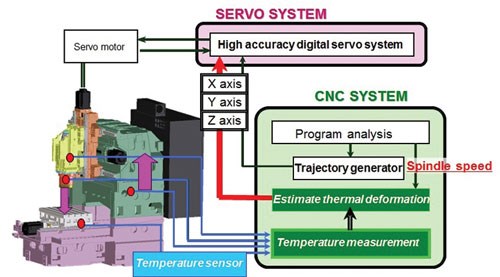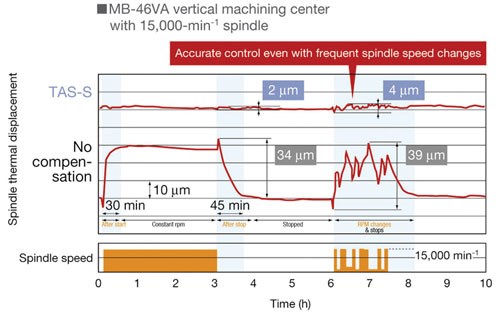Thermal growth due to heat sources is inherent to all machining processes. Heat is generated by machine components as they function as well as by the cutting operations machines perform. Plus, the ambient temperature on a shop floor can vary widely, especially in a facility that’s not environmentally controlled. All of these situations can adversely affect machining accuracy and repeatability over time. They can also extend requisite machine warm-up periods and increase the number of manual offset adjustments operators need to perform throughout the day.
Some machines offer an automated means to adapt to changing thermal conditions. In fact, sensor and control technology have matured to the point that gathering the vital temperature readings necessary for compensation isn’t terribly challenging. However, Tim Thornton, controls products specialist for
Okuma, notes that the key for effective compensation lies in a machine’s basic construction. He says proper compensation can be applied only when machines are designed for predictable thermal growth.
According to Mr. Thornton, Okuma machines are constructed to ensure that thermal deformation occurs only in linear axes. For example, spindles and turrets on the company’s turning centers move axially at the same angle, so when they grow due to heat, they grow along the same plane. Similarly, Okuma mills feature bridge-type designs with “box-build” structures instead of C-frames. That’s because C-frames unpredictably twist and grow at odd angles, making it impossible to accurately compensate for thermal deformation, he notes.
Okuma refers to its overall approach to thermal compensation as its “Thermo-Friendly Concept.” This concept combines the capabilities of its open-architecture Thinc-OSP control, machine construction that makes thermal growth predictable, and machine design elements (such as quality machine covers and effective peripheral equipment placement to eliminate “hot spots”) that help equalize ambient temperatures.
This approach uses two Thermo-Active Stabilizer (TAS) systems to monitor growth within the spindle and machine construction (TAS-S and TAS-C, respectively). TAS-S, a standard feature on many of the company’s mills and multitasking lathes, considers not only spindle temperature, but also spindle rotation, spindle speed changes and spindle stoppage to accurately compensate for spindle deformation. Conversely, TAS-C is based on characteristics of machine construction.
With appropriately placed temperature sensors and feed-axis position data, TAS-C can predict and accurately control thermal deformation of machine components. (TAS-C is standard with many of Okuma’s mills as well as turning centers that offer a Y-axis.) Mr. Thornton says that the company’s large, double-column machines also offer the ability to input, workpiece coefficient of expansion (by simply entering the material type) to compensate for workpiece thermal growth. This is helpful, for example, when it’s necessary to hold tight true-position tolerances over a long distance.
The Thermo-Friendly Concept is one of Okuma’s Intelligent Technology offerings, control capabilities that also include the Collision Avoidance System (CAS) and Machining Navi. CAS integrates a complete 3D model of the machine, workpiece and tooling within the Thinc-OSP control. Running a real-time virtual application of an operation seconds ahead of actual cutting helps detect problems early and will stop the machine before a costly collision occurs. Machining Navi assists operators by recommending optimal cutting conditions and parameters to suppress chatter.




























.jpg;maxWidth=300;quality=90)







